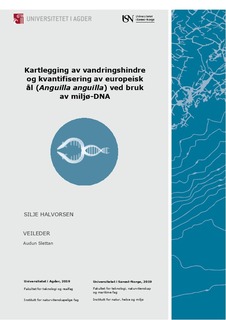| dc.description.abstract | Europeaneel (Anguilla anguilla) is an endangered species nationally and internationally, and the EU-Commissionhas decided that conservation effort is needed. One of the challenges in Norway is obstacles in migration routes, especially where riversareput in pipes underneath roads. In addition, knowledge regarding biomass is essential in conservation work. In this study, environmental DNA (eDNA) has been investigated as a tool for mapping migration obstaclesfor eel.The possibility of usingindividual differences in eDNAto separate individuals, as an estimation of biomass, was also investigated. eDNA is DNA that organisms shed to the environment in e.g. cells or tissue. In the first part of the study, 26 potential migration route obstacles in Aust-and Vest-Agder wereinvestigated by taking a water sample upstream and downstream from each construction, before eDNA from the sample was isolated and analysed by Real-Time PCR (qPCR) with specific primers and probes matching A. Anguilla. The results revealed that eelsweredetectable upstream and downstream in 22 of the locations. These results suggestthat the majority of constructions werenot obstacles forthe migration, but it is also possible that theeels used alternative routes to pass the obstacles. In one of the locations,eels were detecteddownstream, but not upstream. Thepipelinedid not seem like an obstacle, so there wasprobablylow abundance of eels in the area. In the last three potential obstacles, it was not possible to detect eels upstream or downstream, which isprobablydue to other factors. In the second part of the study, the possibility of separatingindividuals of European eel witheDNA from water sampleswas investigated.The study was conducted with two controlexperiments, one with amix of genomic DNA, the second with eDNA collected from a closed system, both with known numbersand haplotypes ofeels. Ten eels werefished, and tissue samples weretaken from each individual. The individuals were then placed in atank filled with waterfor one hour. Water sample was then takenfrom the tank and the river.DNA was isolated, and atarget sequence in the D-loop region in mitochondria-DNA was amplified and sequenced from each of the ten individuals, for amixed sample of the ten individuals, and from a water sample from the tank and the river. The results suggested that each of the ten individuals had different haplotypes, which allwasfound in the mixed sample, and in the samplefrom the water tank. In the sample from the river,the main goal,there was with high degree of certainty found three different haplotypes of European eel (n > 1000). Considering earlier publications about haplotype diversity from European eel, which is found to be h = 0,99, it is possible to suggest that there werethreeindividuals of eel in found in the water sample from the river. | nb_NO |

